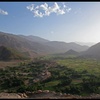Disclaimer
This entry contains information known to us from a variety of sources but may not include all the information currently available. Please be in touch if you notice any inadvertent mistakes in our presentation or have additional knowledge or sources to share. Thank you.
Archive
Shrine of Sidi Moussa at Tabant, Morocco
In the remote High Atlas Mountains lies a lush hidden valley accessible only via a solitary, winding road. that winds through the mountains. The dramatic valley floor is punctuated by two pyramid-like mini-mountains, each capped by a round mud granary that surrounds the tomb of holy men: Sidi Moussa (Lord Moses) and Sidi Chitta (Lord Chitta) both Jews, according to local legend.
Description
Setting: The Ait Bougmez Valley is known as the happy valley, apparently reflecting the friendly disposition of its residents. Tucked away in a remote corner of the Atlas Mountains, Ait Bougmez sits in the shadow of the M’goun Massif, the area's tallest peak. Well irrigated with streams fed by mountain snow, the green valley features a mosaic of green fields in geometric patterns. Small clusters of red clay homes dot the valley.
Agadir: Due to its remote location, the valley was a part of Morocco known as Bled Siba, the countryside uncontrolled by the king's forces. The lack of a dominant power meant tribes often fought battled one another for power. Local villages would create a communal granary, or "agadir" in Tamazigh (the Berber language), to store supplies and to provide shelter in the event of a siege. To maximize security, the agadir would ideally be placed on a hilltop or peak with a panoramic view of the surroundings.
Shrines: The shrines of Sidi Moussa and Sidi Chitta are classical examples of agadirs. Sidi Moussa sits on a conical hill above a village called Tabant. A few miles away, atop a parallel hill, stands the Sidi Chitta agadir. The buildings, divided into small rooms where local families store their grain, are squat, circular structures with four stone turrets offering strategic look-out spots. Inside, a spiral staircase leads to the upper floors and roof.
Current Status: Today, the Ait Bougmez Valley does not see inter-tribal conflict, and so the Sidi Moussa shrine has been turned into a cultural museum spotlighting the valley’’s traditional folk-craft. The shrine's guardian, who claims he is 120 years old, climbs the hill every morning to administer the small museum and offer visitors tea.
Jewish Roots: Little is known about the two saints, who are remembered as pious men with remarkable healing powers. Many locals, particularly older residents of the valley, share the legend that the men were rabbis. Local women often visit the shrine to seek alleviation of cases of infertility, a power Berber Muslims often associate with Jewish marabouts (holy men). Several small Jewish communities once thrived in the Ait Bougmez Valley (one community was the subject of a sociological study), with the most prominent being the Jewish village of Assamer outside Ait Bouli. Jews and Muslims appear to have had a complex relationship in the valley, and it is in keeping with patterns of such interactions that Muslims might venerate a Jewish saint.
Sources
Schatzker, Chaim. “Confronting the Religious Question within the Zionist Youth Movement,” in Zionism and Religion, ed. S. Almog, Jehuda Reinharz, Anita Shapira (Hanover: New England University Press, 1998),320. Accessed March 16, 2014, http://books.google.com/books?id=mS6oW4TTuwkC&lpg=PA320&vq=bouli%20shokeid&dq=ait%20bouli%20shokeid&pg=PA320#v=onepage&q&f=false.
Shokeid, Moshe. The Dual Heritage: Immigrants from the Atlas Mountains in an Israeli Village (Manchester: Manchester University Press, 1971), 16. Accessed March 16, 2014, http://books.google.com/books?id=lRgNAQAAIAAJ&lpg=PP1&dq=shokeid%20dual%20heritage&pg=PA16#v=onepage&q&f=false.


